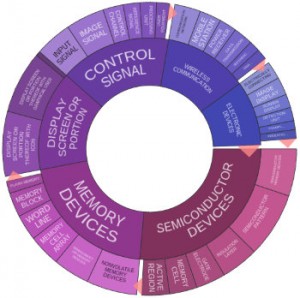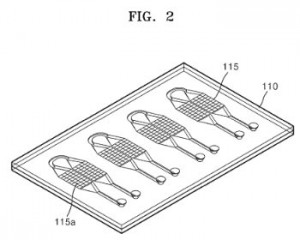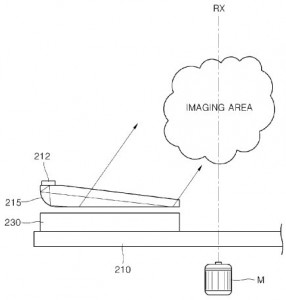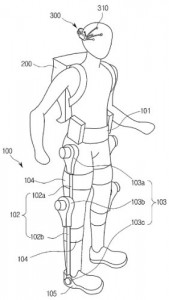 Samsung Electronics (KRX:005930) of Suwon, South Korea, is a developer of personal and home electronics from large screen television sets to pocket-sized smartphones. As of this writing, Samsung is the top smartphone vendor in the United States and its Galaxy S5 and Galaxy S6 phones are the top and third-best selling mobile phones in America, respectively. Although the Galaxy relies on the Android mobile operating system, Samsung has sold more than one million devices which use the company’s proprietary Tizen OS, which the company hopes it can use to break away from its dependence on Android. Although the Tizen system offers far fewer apps and functionality than Android at the moment, Samsung is interested in increasing the number of devices it sells which come with Tizen by the end of the year.
Samsung Electronics (KRX:005930) of Suwon, South Korea, is a developer of personal and home electronics from large screen television sets to pocket-sized smartphones. As of this writing, Samsung is the top smartphone vendor in the United States and its Galaxy S5 and Galaxy S6 phones are the top and third-best selling mobile phones in America, respectively. Although the Galaxy relies on the Android mobile operating system, Samsung has sold more than one million devices which use the company’s proprietary Tizen OS, which the company hopes it can use to break away from its dependence on Android. Although the Tizen system offers far fewer apps and functionality than Android at the moment, Samsung is interested in increasing the number of devices it sells which come with Tizen by the end of the year. 
In the world of patents, Samsung operates in the highest sphere of innovation. In 2014, Samsung Electronics was second overall among companies receiving U.S. patents with 4,952 patents that year, according to statistics collected by IFI Claims. That’s a little more than 13.5 patents every day over the course of a year. During the second quarter of 2015, Samsung earned 1,506 patents from the U.S. Patent and Trademark Office, much of which are directed at semiconductor devices and memory devices. We’ve been covering a lot of the most recent developments in the field of wearable technologies, which is why we were interested to learn that Samsung is the top filer of patent applications related to wearable technologies, accounting for about four percent of the 41,301 patents making up the wearables field according to a study by Lux Research of Boston, MA.
Despite strong mobile sales, some are predicting some turbulent financial waters for Samsung when it releases its second quarter earnings report in the coming weeks. Some financial analysts expect that the company will report a 24 percent reduction in profits over 2014’s second quarter. Samsung is trying to tap into enterprise markets with its mobile devices, which have typically been seen as consumer products, with a business-to-business campaign emphasizing employee productivity and Samsung’s mobile security features. The company also recently fought off an activist investor’s court challenge to a merger of Samsung C&T Corporation and Cheil Industries, which was already a Samsung affiliate, a move which seems to be fueled by a desire to consolidate family ownership of Samsung prior to a coming intergenerational change in ownership.
[Companies-1]
Samsung’s Issued Patents: Solar-Powered Devices and Genomic Diagnostics
It’s not surprising that so much of Samsung’s recently issued patents would focus on improvements to the various electronic computing devices manufactured by the company. Samsung is attempting to take advantage of the unique physical properties of graphene in its products with the technology protected through U.S. Patent No. 9053932, titled Methods of Preparing Graphene and Device Including Graphene. The method of preparing graphene which is claimed here involves forming a silicon carbide thin film on a substrate, forming a metal thin film on the silicon carbide thin film and heating both films to form both a metal silicide layer and graphene. The improvements to graphene production pioneered here will give Samsung a greater ability to incorporate graphene, which the patent points out has a charge mobility 100 times faster than silicon and a current density 100 times greater than copper. More solar powered devices could be the result of the technology discussed in U.S. Patent No. 9065297, titled Method and Apparatus for Charging Battery Using Solar Battery. The method claimed here involves charging a battery with a first charging current from a charging unit, detecting the output state of a solar cell varying according to intensity of light or temperature, identifying the amount of a second charging current corresponding to the solar cell’s output and charging the battery with a current having the amount of the  identified solar cell output. An interesting device innovation intended to mitigate some of the negative health impacts of extended device use is at the center of U.S. Patent No. 9047011, titled Apparatus and Method for Providing a Dynamic User Interface in Consideration of Physical Characteristics of a User. The apparatus for providing a dynamic user interface claimed here includes an acquirer that acquires touch information about a user’s touchscreen interactions and multiple estimators that estimate where a user touches the screen and whether a user is suffering too much joint stress. This system for determining the optimal touch region of a touchscreen and reducing a device user’s possibility of developing carpal tunnel syndrome.
identified solar cell output. An interesting device innovation intended to mitigate some of the negative health impacts of extended device use is at the center of U.S. Patent No. 9047011, titled Apparatus and Method for Providing a Dynamic User Interface in Consideration of Physical Characteristics of a User. The apparatus for providing a dynamic user interface claimed here includes an acquirer that acquires touch information about a user’s touchscreen interactions and multiple estimators that estimate where a user touches the screen and whether a user is suffering too much joint stress. This system for determining the optimal touch region of a touchscreen and reducing a device user’s possibility of developing carpal tunnel syndrome.
Medical and healthcare innovations were at the center of couple of patents that caught our eyes today. The analysis of a person’s speech to diagnose certain health conditions is possible through the technology outlined within U.S. Patent No. 9055861, which is titled Apparatus and Method of Diagnosing Health by Using Voice. The health diagnosing apparatus claimed here includes a voice detecting unit, a voice analyzing unit, a voice diagnosing unit which compares a speaker’s voice to reference vocal data, a warning outputting unit and a diagnosis outputting unit. Samsung is also looking to improve its point-of-care healthcare technologies using a genomic sequencing capability protected through the issue of U.S. Patent No. 9044751, issued under the title Gene Analysis Device. The gene analysis device disclosed here includes a microfluidic device with a bio-reaction space and at least one micro-chamber, an illumination optical system that radiates excitation light onto the micro-chamber and a detection optical system with a photodetector that detects a fluorescence signal generated by a bio-reaction. The increased intensity of the fluorescence signal of this invention addresses limits of detection in gene analysis devices which utilize polymerase chain reaction (PCR) bio-reactions.
a voice diagnosing unit which compares a speaker’s voice to reference vocal data, a warning outputting unit and a diagnosis outputting unit. Samsung is also looking to improve its point-of-care healthcare technologies using a genomic sequencing capability protected through the issue of U.S. Patent No. 9044751, issued under the title Gene Analysis Device. The gene analysis device disclosed here includes a microfluidic device with a bio-reaction space and at least one micro-chamber, an illumination optical system that radiates excitation light onto the micro-chamber and a detection optical system with a photodetector that detects a fluorescence signal generated by a bio-reaction. The increased intensity of the fluorescence signal of this invention addresses limits of detection in gene analysis devices which utilize polymerase chain reaction (PCR) bio-reactions.
 We also took note of a Samsung technology developed for the kitchen laid out within U.S. Patent No. 9060389, entitled Induction Heating Cooker. It protects an induction heating cooker with a plurality of heating coils and switching elements configured to power the heating coils to perform bidirectional heating when turned on. This innovation results in an induction heating cooker which is smaller in size without having to increase the number of inverters installed on the unit, which increases the costs of manufacturing.
We also took note of a Samsung technology developed for the kitchen laid out within U.S. Patent No. 9060389, entitled Induction Heating Cooker. It protects an induction heating cooker with a plurality of heating coils and switching elements configured to power the heating coils to perform bidirectional heating when turned on. This innovation results in an induction heating cooker which is smaller in size without having to increase the number of inverters installed on the unit, which increases the costs of manufacturing.
Patent Applications of Note: Samsung Augments Reality and Improves Natural Walking with Robotics
We noticed a series of patents related to augmented and virtual reality technologies during our most recent scroll through Samsung’s patent applications filed at the USPTO. Electronics for improving sensory feedback returned to a person in an immersive virtual environment are described within U.S. Patent Application No. 20150169065, which is titled Method and Apparatus for Processing Virtual World. This would protect an apparatus that can process haptic information of an object in a virtual world and transmit tactile feedback through a device to a user. This provides touch feedback resulting from an interaction in the virtual world for an improved interaction between the real and virtual  worlds. An improved three-dimensional image display that would cause less eye fatigue in viewers is detailed in U.S. Patent Application No. 20150160611, filed under the title Holographic Display. The patent application claims a holographic display with a support plate rotatable on a rotary axis, a plurality of spatial light modulators arranged on the support plate at a distance from the axis, an optical path conversion device that guides emitted light, an image signal input device that sends holographic image signals to the spatial light modulators and an imaging area where the holographic image is displayed. This innovation is designed to overcome limitations in presenting a natural stereoscopic view to many viewers without the use of binocular parallax, the presentation of different images to the right and left eye which can cause eye fatigue and may not appear as intended depending on the angle at which a person sees the image. A method of incorporating augmented reality technologies into social network systems is featured within U.S. Patent Application No. 20150172376, titled Method for Providing Social Network Service and Electronic Device Implementing the Same. The method for providing a social network service disclosed here involves extracting feature information from camera and microphone inputs, transmitting extracted feature information to a server, receiving information and a memo associated with social network users who match the feature information as well as displaying the information and memo. This technology is designed to make it easier to incorporate real-life experiences captured in photos or other media into online social networks.
worlds. An improved three-dimensional image display that would cause less eye fatigue in viewers is detailed in U.S. Patent Application No. 20150160611, filed under the title Holographic Display. The patent application claims a holographic display with a support plate rotatable on a rotary axis, a plurality of spatial light modulators arranged on the support plate at a distance from the axis, an optical path conversion device that guides emitted light, an image signal input device that sends holographic image signals to the spatial light modulators and an imaging area where the holographic image is displayed. This innovation is designed to overcome limitations in presenting a natural stereoscopic view to many viewers without the use of binocular parallax, the presentation of different images to the right and left eye which can cause eye fatigue and may not appear as intended depending on the angle at which a person sees the image. A method of incorporating augmented reality technologies into social network systems is featured within U.S. Patent Application No. 20150172376, titled Method for Providing Social Network Service and Electronic Device Implementing the Same. The method for providing a social network service disclosed here involves extracting feature information from camera and microphone inputs, transmitting extracted feature information to a server, receiving information and a memo associated with social network users who match the feature information as well as displaying the information and memo. This technology is designed to make it easier to incorporate real-life experiences captured in photos or other media into online social networks.
 We’ve covered both wearable tech and robotic innovation here on IPWatchdog and we noticed one very interesting Samsung invention which melds these two sectors. U.S. Patent Application No. 20150164731, titled Wearable Robot and Method of Controlling the Same, would protect a method involving the measure of electrical signals from the scalp of a wearer, estimating the wearer’s current walking speed and outputting assistive torque so that the estimated walking speed approaches a target walking speed. This wearable robot has a variety of applications, from restoring mobility to elderly and disabled persons as well as assisting military personnel lifting heavy military gear.
We’ve covered both wearable tech and robotic innovation here on IPWatchdog and we noticed one very interesting Samsung invention which melds these two sectors. U.S. Patent Application No. 20150164731, titled Wearable Robot and Method of Controlling the Same, would protect a method involving the measure of electrical signals from the scalp of a wearer, estimating the wearer’s current walking speed and outputting assistive torque so that the estimated walking speed approaches a target walking speed. This wearable robot has a variety of applications, from restoring mobility to elderly and disabled persons as well as assisting military personnel lifting heavy military gear.
Samsung’s appliance innovation extends beyond the cooking technology discussed above into cleaning appliances, like the one we saw in U.S. Patent Application No. 20150167223, titled Washing Machine Using Bubbles. The washing machine claimed by this patent application has a control unit which controls both the water supply and detergent supply devices to generate bubbles of detergent dissolved water that can wash functional clothes, especially sports clothes. This innovation achieves washing performance suitable for hiking clothes or ski wear, among other items of sports clothing, which may have fibers or surface structures that can be deteriorated through general mechanical washing.
 We’ll wrap up with a look at two digital services developed by Samsung which grabbed our attention. Samsung seems to be trying to leverage the ubiquity of personal electronic devices for a daily task management scheme which is outlined in U.S. Patent Application No. 20150161572, which is titled Method and Apparatus for Managing Daily Work. The patent application discloses a method of recording data related to an event when an event related to daily work is detected and displaying on a screen the details of the daily work which were generated by the recorded data. The invention is designed to function as a life-logging service which can collect situational information from personal conversations and other events to improve the management of daily work. An improvement to Samsung Pay, the company’s entry into the digital wallet market, is the focus of U.S. Patent Application No. 20150170120, titled Method of Providing Payment Services and Messenger Server Using the Method. The patent application claims a method in a user terminal device of receiving a request for a payment of goods from a seller server, determining payment information of the user receiving the payment request and then sharing that information with the seller server. This innovation was pursued in order to streamline the process of using a digital wallet to make a payment, which may involve utilizing different interfaces for each seller or manually inputting payment information.
We’ll wrap up with a look at two digital services developed by Samsung which grabbed our attention. Samsung seems to be trying to leverage the ubiquity of personal electronic devices for a daily task management scheme which is outlined in U.S. Patent Application No. 20150161572, which is titled Method and Apparatus for Managing Daily Work. The patent application discloses a method of recording data related to an event when an event related to daily work is detected and displaying on a screen the details of the daily work which were generated by the recorded data. The invention is designed to function as a life-logging service which can collect situational information from personal conversations and other events to improve the management of daily work. An improvement to Samsung Pay, the company’s entry into the digital wallet market, is the focus of U.S. Patent Application No. 20150170120, titled Method of Providing Payment Services and Messenger Server Using the Method. The patent application claims a method in a user terminal device of receiving a request for a payment of goods from a seller server, determining payment information of the user receiving the payment request and then sharing that information with the seller server. This innovation was pursued in order to streamline the process of using a digital wallet to make a payment, which may involve utilizing different interfaces for each seller or manually inputting payment information.

![[IPWatchdog Logo]](https://ipwatchdog.com/wp-content/themes/IPWatchdog%20-%202023/assets/images/temp/logo-small@2x.png)

![[Advertisement]](https://ipwatchdog.com/wp-content/uploads/2024/04/Patent-Litigation-Masters-2024-sidebar-early-bird-ends-Apr-21-last-chance-700x500-1.jpg)

![[Advertisement]](https://ipwatchdog.com/wp-content/uploads/2021/12/WEBINAR-336-x-280-px.png)
![[Advertisement]](https://ipwatchdog.com/wp-content/uploads/2021/12/2021-Patent-Practice-on-Demand-recorded-Feb-2021-336-x-280.jpg)
![[Advertisement]](https://ipwatchdog.com/wp-content/uploads/2021/12/Ad-4-The-Invent-Patent-System™.png)







Join the Discussion
No comments yet.